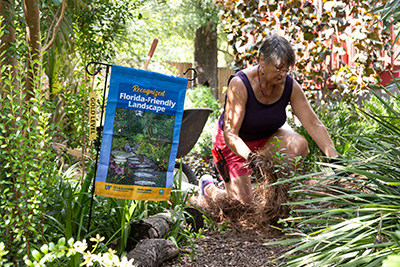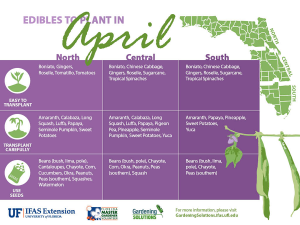Florida Gardening for New Residents

If you’re new to Florida, we recommend taking a look at the nine Florida-Friendly Landscaping™ principles to help you learn how to have a healthy and beautiful landscape that protect Florida’s natural resources.
For gardeners who have recently moved to Florida, adjusting to the Sunshine State’s unique climate, seasons, soil, and species can be challenging. With eight distinct USDA Hardiness Zones, the variety of ornamental, edible, and native plants that happily grow in Florida is staggering.
Here are our top five suggestions for adapting your gardening practices to your new home.
Rethink Growing Seasons
Here in Florida the winters are mild but the summers can be brutal. You may need to re-think which months are part of the “growing season,” based on where in the state you’re located. Below are our suggestions for understanding the growing season in your area:
North Florida (North of S.R. 40)
North Florida includes USDA Hardiness Zones 8 and 9. These zones enjoy a true year-round growing season. You can find the best time to plant, check for pests, prune, and fertilize in the North Florida Gardening Calendar.
The Florida Vegetable Gardening Guide can help you find the correct planting dates for annual crops in your area. Traditional “summer crops,” like summer squash, are usually planted here in the winter, for example.
Central Florida (Between S.R. 40 and S.R. 70)
Central Florida includes USDA Hardiness Zones 9 and 10. The weather in this region varies from year to year. Some years Central Florida goes without a hard freeze. Other years a cold snap can knock tropical plants back to the ground. You can find the best time to plant, check for pests, prune, and fertilize in the Central Florida Gardening Calendar.
The Florida Vegetable Gardening Guide can help you find the correct planting dates for annual crops in your area. Late summer is so hot and wet that most garden crops decline sharply at this time. Check the recommended planting dates and vegetable varieties to avoid losing your harvest.
South Florida (South of S.R. 70)
South Florida includes USDA Hardiness Zones 10 and 11. Summers in these zones are long and hot. You can find the best time to plant, check for pests, prune, and fertilize in the South Florida Gardening Calendar.
The Florida Vegetable Gardening Guide can help you find the correct planting dates for annual crops in your area. You’ll recognize many crops that are also grown up north, but they’re planted in the fall in South Florida. They will produce through the end of the spring, almost a mirror image of the growing seasons in the northern United States.
Plan for the Rainy Season

In Florida we have true rainy and dry seasons. Winter and spring are our driest months of the year. Beginning in summer the rainy season stretches from June to October. You can expect afternoon rains almost every day during these months. These cloudbursts are usually short and the sunshine returns quickly, so they’re easy to plan around.
Water flow becomes a serious landscaping concern during the rainy season. It’s best to address drainage problems as soon as you notice them, and before heavier rains and seasonal storms compound the problem.
For your plants, the rainy season means abundant water, but also an increased risk of fungal pests. Some turfgrasses are also sensitive to excess moisture. Adjusting your irrigation can make a big difference in your lawn’s health. On the other hand, all that rain makes summer a convenient time to plant palms, shrubs, and small trees.
You’ll find more information here on Gardening Solutions:
Consider the Soil, Sand, and Salt
One of Florida’s many charms is that no matter where you are, there’s likely to be a beach nearby. Gardening in a state with such an extensive coastline requires a little extra planning to deal with the relentless sand, limestone, and salt.

“Mayakka fine sand” is the most common soil type in the state. It extends far inland and covers more than a million acres of land. The panhandle region is less sandy, but gardeners there battle tough clay deposits. Further south the soil is very shallow and the limestone bedrock raises the pH to alkaline levels. A jackhammer is sometimes required to begin a new garden in South Florida. Regardless of your soil type, we suggest beginning with a soil test. Detailed directions come with a soil sample kit, which you can get from your county Extension office or the IFAS Extension soil testing laboratory.
More than three-quarters of Florida’s population lives in coastal counties. There, salt plays as major a role as the sand. If you live within an eighth of a mile of the coast, we suggest landscaping with salt-tolerant plants. The Gardening Solutions articles below can help you choose annuals, perennials, and turf that can thrive in coastal environments:
- Working in Your Florida Soil
- Organic Soil Amendments
- Coastal Landscapes
- Salt-tolerant Plants
- Salt-tolerant Lawngrasses
“Ask IFAS,” the UF/IFAS publications database also has articles on salt-tolerant plants.
Know Your Invasive Species

A year-round growing season and plenty of international commerce make Florida a hotspot for invasive plants, pests, and wildlife.
Many species that are beloved up north are a problem here in the Sunshine State. Japanese honeysuckle (Lonicera japonica) and European blackberry (Rubus fruticosus), for example, are on the Florida Noxious Weeds list.
You can help keep Florida as beautiful as the day you arrived. Stay up to date on threats from invasive plants and wildlife with the links below:
- UF/IFAS Assessment of Non-native Plants in Florida’s Natural Areas
- UF/IFAS Center for Aquatic and Invasive Plants
Call Your County Extension Office
Florida is a marvelous place to live, but it certainly requires some adjustment. As you adapt to your new home, the county Extension office is here to help. Our local Extension staff and volunteers would be happy to help answer questions about plants, pests, irrigation, lawn care, and much, much more. Reach out to your county Extension office.

